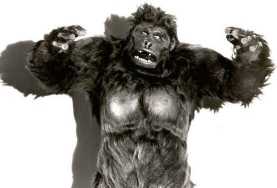
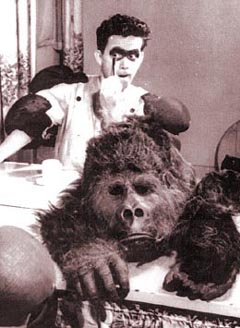
 |
The Ape Suit Saga: |  |
Men in gorilla suits have been a part of movie-making since its earliest days. Coming into the sound era, the many films of the 1930s and 1940s which featured gorillas involved only two hard-working performers, Charles Gemora and Ray “Crash” Corrigan. These two actors built unique, very realistic costumes which appeared in too many movie features and serials to count off here. When science fiction films became popular in the 1950s, Gemora and Corrigan also appeared in “space alien” suits, Gemora in War of the Worlds and Corrigan in It, the Terror from Beyond Space.
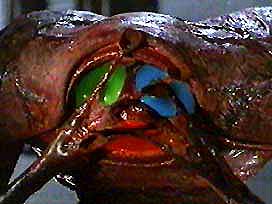 |
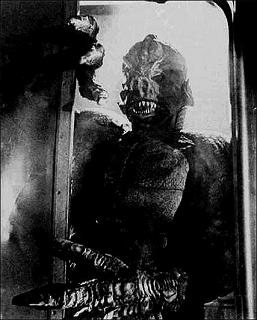 |
Gemora was a short, thin Filipino, who wore heavy padding and mastered the “body english” that convinced you there was a real gorilla present. Corrigan was a tall, husky character who had starred in a number of cowboy films and serials; in later years, he built a famous western town, “Corriganville,” which was used extensively in western films and TV series. A disciple of Gemora, Bob Burns, built his own gorilla suit in the mid-1960s and, using two different heads, appeared both as a male and female gorilla on many TV programs of that period. Gemora had died in 1961.
The fact that the science fiction movie boom of the 1950s did not die out in the 1960s convinced a number of artists that making monster suits was a potential way to earn a good living. Prominent in the US was John Chambers, who made all the ape suits used in the Planet of the Apes film series released beginning in 1968. Prominent in the UK was Stuart Freeborn who made the amazing ape suits seen in 2001: A Space Odyssey, also in 1968.
This brings us to pseudoscience, and to Bigfoot, and to Roger Patterson. Patterson had pretty much retired from rodeo riding in 1960 and went heavily into the business of “finding” (or creating) evidence for Bigfoot over the next few years. He self-published a book about Bigfoot in 1966, and announced his next project was to be a Bigfoot documentary film. He obtained a 16 mm movie camera and some color film stock, and by October of 1967 he had 28 feet (about 950 frames) of film of a Bigfoot walking away from his camera into woods.
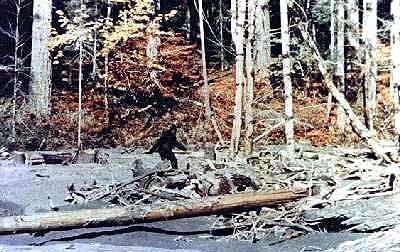 |
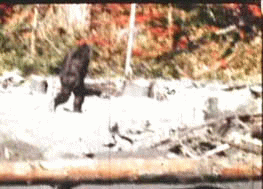 |
Back to ape suits. Every Hollywood special effects man who has ever viewed the Patterson footage says positively that it shows a man wearing an ape suit. But whose ape suit? The special effects men usually implicate John Chambers, because he was about the only man in Hollywood who was building ape suits in 1967. However, Chambers, who died at 78 in August of 2001, said in a 1997 interview that he did not know Patterson and had not made the suit shown in the Patterson film. Chambers, however, did create a Bigfoot. It seems to have been constructed for a sideshow, since it was intended to be exhibited as a “dead, preserved specimen.” It was formed over a body cast of actor Richard Kiel, 7 feet and 4 inches tall, who appeared in a number of films of the 1960s as villain or monster. The ultimate fate of this so-called “Burbank Bigfoot” exhibit is unknown. The world of carnival sideshow exhibit manufacture is highly specialized and fairly secretive. It is important to realize that there were a couple of shops in Hollywood, unconnected with either Chambers and his crew, or any other Hollywood special effects team, who made carnival and side-show exhibits exclusively. The famous “Minnesota ice man,” intended to be exhibited in side shows apparently frozen inside a large cake of ice, was a very realistic ape-man constructed by Pete Corrall in April of 1967 for one of these shops. This exhibit completely fooled two very naive zoologists in December of 1968.
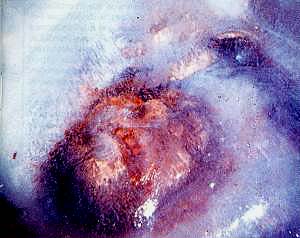 Minnesota Iceman exhibit |
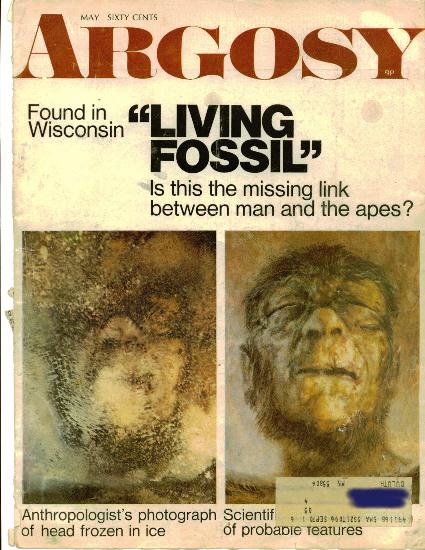 At some point the “Minnesota” iceman got attributed to Wisconsin. |
About the only professionally qualified zoologist who has ever gone through all the “evidence” for Bigfoot to date (which of course is not evidence at all in any scientific sense) is David Daegling, an expert in early hominid anthropology. His comment: “There's a ton of evidence for Bigfoot--- a mountain of evidence. The problem is that none of that evidence is any good!” Concerning the Patterson Bigfoot film, he notes that the “walk” of Bigfoot in the film is the comical “compliant gait” which Groucho Marx uses in most of his early films.
The Patterson footage can be duplicated precisely by a man in an ape suit, but that leaves the question of, “whose ape suit is it?” And the answer leads to magician and costumer Philip Morris. In the late 1950s and early 1960s Morris was active in the “Ghost Show” industry. If you don't know what a ghost show was, read Ghostmasters, by Mark Walker (Cool Hand, 1991, 1994)! The ghost show was a live performance lasting about an hour, which played near midnight in movie theaters, and was usually followed by showing of a low-budget horror film. The leader of the ghost show was a magician who did some horror-themed magic tricks, and then “unleashed" a live gorilla, a Frankenstein Monster, a mummy and whatever other costumes he had out into the screaming audience.
This led Morris to ponder the
market's lack of a good, inexpensive gorilla costume... he
needed one himself. Morris and his wife discovered a way to make
very realistic gorilla and bear costumes, and in 1967 were
advertising them for sale in show-business magazines. The
gorilla outfit cost $435, the bear outfit $335. Morris went on
to become the largest seller of costumes in the U.S. The last
catalog got from him, Morris Costumes 2001-2005 Catalog,
was more than 600 pages long, with about 15 pages of gorilla
costumes and accessories. Currently (2023), the company
still exists, with an on-line catalog, and you can visit it here.
According to Morris, who was interviewed in 2003, in the summer of 1967 he got a call from Roger Patterson, who said he wanted to purchase a gorilla suit for a “rodeo act.” He bought the $435 suit, and later called to ask how to hide the zippers, extend the arms, and bulk up the shoulders. In October of 1967, Morris had the pleasure of seeing Patterson's footage of his costume on TV.
Gorilla costumes are still readily available, from Morris's company and many other sources. Cost is typically from $1000, for a really good suit, down to $25, for a jump suit with some fur glued to it. Morris' own line of ape costumes in the 2005 catalog ranged in price from $475 to $1,900. A search on the internet will provide images of typical outfits. One problem with almost all the outfits, whatever their cost, is a somewhat unrealistic head and a somewhat unrealistic chest piece. It is notable in Patterson's film that the ape head and chestpiece are not used. The performer in the Patterson film is instead wearing a bushy wig and beard matching the suit, with his eyes, nose and cheeks clearly visible. The performer also appears to be wearing a kind of bulky, diaper-like padding, whose edges show clearly through the outer layer of the suit. A lot of gorilla costumes have “breasts,” as you can see by surfing costume-shop websites, but they don't look realistic, being intended to appear as bare black gorilla-skin. Patterson replaced the chest-piece by adding some fur-covered waterbags. Saline, or silicone, not specified! It makes his Bigfoot look quite feminine, particularly with the fine “bootie" the diaper supplies. [Female apes do not have pendulous breasts like those exhibited by the Patterson suit. Instead they are quite flat-chested. Our hero was apparently inspired to create the set shown by some “eyewitness” sightings of female Bigfeet with huge knockers that he had collected for a book.]
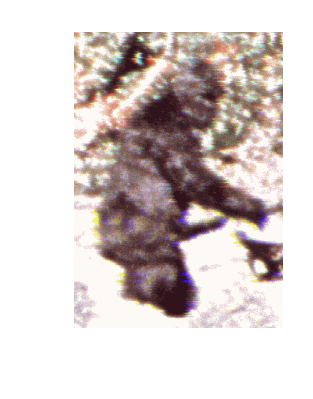 |
If you wish to make your own [insert your local] County Bigfoot video tape, local costume shops have available for rent a wide range of ape costumes. Some are pretty shabby, others are quite realistic. You probably will not want to use the head and chest-piece— after all, nobody knows what Bigfoot's facial features might be like. A dark beard and shaggy long dark wig are going to be pretty convincing. Remember, don't get the camera too close! You want the apeman to be very small in the frame, so that any image that shows it in detail would have to be a very fuzzy, extreme enlargement. Keep the image shaking— you're supposed to be excited! Also remember your ape actor needs to put on lots of padding (Gemora wore football pads) to fill the space between his body and the suit; you don't want the legs to flap around like a pair of dress pants. A padded or quilted set of hunter's coveralls might work fairly well. [Many on-line and even local costume shops sell ape suits. If you want one, since a good one is very expensive, ask about rentals.] |
To see a complete full-frame on-line version of Rodger Patterson's original footage, click here.